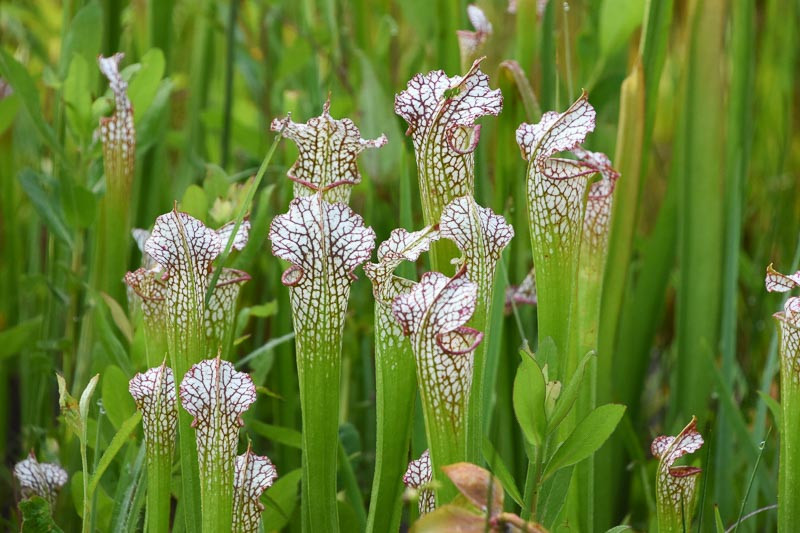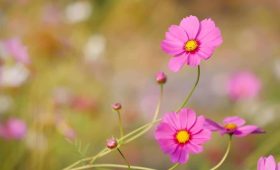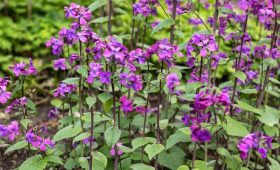memme.info – The White-Topped Pitcher Plant (Sarracenia leucophylla) is a striking and unique carnivorous plant native to the southeastern United States. Known for its beautiful, white-topped tubular leaves and distinctive flowers, this plant is a marvel of nature, both for its intricate beauty and its unusual method of obtaining nutrients. The White-Topped Pitcher Plant, a member of the Sarraceniaceae family, is often found in wet, acidic bogs, where it thrives in nutrient-poor soil by capturing and digesting insects. This article delves into the intriguing characteristics of the White-Topped Pitcher Plant flower, exploring its appearance, habitat, and care requirements.
Appearance and Characteristics
The White-Topped Pitcher Plant is an evergreen perennial that produces long, tubular leaves, or “pitchers,” that serve as both a trap for insects and a distinctive feature of the plant’s morphology. The pitchers are typically green with red veins, creating a vibrant contrast against the plant’s bright white or pale-colored, hood-like “top” that gives the plant its name. The top of the pitcher is a tubular structure with a white, veined, or mottled appearance that acts as a visual lure for insects.
The plant’s flower is equally captivating and emerges in the spring, typically before the new pitchers unfurl. The flowers are large, showy, and somewhat nodding, with distinctive features that set them apart from other flowering plants. The blossoms are composed of five white petals, each with a greenish hue, which form a bell-shaped structure. The flowers are borne on long, slender stems that can rise above the rest of the plant, making the blooms stand out dramatically against the backdrop of the pitcher-like leaves.
While the flower’s striking beauty may initially capture attention, it is the plant’s method of catching prey that makes it truly fascinating. The pitchers trap insects that are drawn to the plant’s sweet nectar, but once inside, the insects become trapped and eventually break down, providing the plant with essential nutrients such as nitrogen.
Habitat and Distribution
The White-Topped Pitcher Plant is native to the wetland areas of the southeastern United States, particularly in regions of Alabama, Georgia, Mississippi, Florida, and Louisiana. It typically grows in boggy, acidic soils that are nutrient-poor, which is why it has evolved to catch and digest insects to supplement its nutrient intake. These bogs are often characterized by high humidity and poor drainage, creating the perfect environment for the White-Topped Pitcher Plant to thrive.
In the wild, the White-Topped Pitcher Plant is typically found in open, sunny areas such as wet meadows, pine barrens, and coastal plains, where it can receive plenty of sunlight. The plant’s ability to grow in such challenging conditions, where other plants might struggle to survive, highlights its unique adaptation to low-nutrient environments.
Ecological Importance
The White-Topped Pitcher Plant plays an important role in the ecosystems where it is found. As a carnivorous plant, it helps regulate insect populations, particularly mosquitoes and other small flying insects. By attracting and trapping these pests, the plant prevents overpopulation, which could otherwise negatively impact the local ecosystem.
The plant’s habitat also supports a diverse range of other organisms, including insects, birds, and amphibians, making the boggy ecosystems where the White-Topped Pitcher Plant thrives a crucial part of the local biodiversity. The presence of these pitcher plants helps to maintain a balanced ecosystem, with the plant itself benefiting from the nutrient-rich prey it captures.
Growing and Caring for White-Topped Pitcher Plant
Growing the White-Topped Pitcher Plant in a garden or greenhouse can be a rewarding endeavor, but it does require specific care and attention to its environmental needs. Here are some essential tips for growing and maintaining this carnivorous beauty:
- Light: The White-Topped Pitcher Plant requires full sunlight to thrive. It should be planted in a location that receives at least six hours of direct sunlight each day. Without sufficient light, the plant may not produce the vibrant pitchers or showy flowers it is known for.
- Soil: This plant requires acidic, well-draining soil. A mixture of sphagnum moss, sand, and perlite is ideal for creating the appropriate growing medium. It is important to avoid using regular garden soil, as it may contain nutrients that can harm the plant. Pitcher plants prefer soil that is poor in nutrients, as they get most of their nutrients from the insects they capture.
- Watering: The White-Topped Pitcher Plant thrives in consistently moist soil, as it is native to wetland environments. It is essential to keep the soil constantly moist but not waterlogged. Rainwater, distilled water, or non-chlorinated water is preferred, as the plant is sensitive to chemicals found in tap water, such as chlorine and fluoride.
- Temperature and Humidity: This plant thrives in warm, humid conditions. The ideal temperature range for the White-Topped Pitcher Plant is between 70°F and 85°F (21°C to 29°C) during the growing season. In cooler months, the plant can tolerate temperatures as low as 50°F (10°C), but it will require a dormancy period. High humidity is essential for the plant’s survival, and a humidity level of 50-70% is recommended. If grown indoors, placing the plant on a humidity tray or using a humidifier can help create the necessary environment.
- Fertilization: The White-Topped Pitcher Plant does not require additional fertilization in the form of traditional plant food. Instead, it obtains nutrients from the insects it captures. If growing the plant in a garden, be cautious about fertilizing the soil, as this can disrupt the plant’s natural carnivorous feeding process.
- Dormancy: In the colder months, the White-Topped Pitcher Plant enters a dormancy period, during which it slows down its growth and may lose some of its pitchers. During dormancy, reduce watering and allow the plant to rest. This period typically lasts from late fall to early spring, and it is important to avoid disturbing the plant during this time.
- Repotting: Over time, the White-Topped Pitcher Plant may outgrow its container. Repotting should be done every 1-2 years to refresh the growing medium and ensure the plant has ample space for its roots to grow. It is important to be gentle when handling the plant, as its delicate pitchers can be easily damaged.
Flowering and Pollination
The White-Topped Pitcher Plant produces its distinctive flowers in the early spring, typically before the new pitchers emerge. The flowers are large and showy, with five white petals that have a hint of green. These bell-shaped blooms are borne on long stems that rise above the rest of the plant, providing a striking contrast against the tubular, pitcher-shaped leaves.
Pollination is typically carried out by insects, including bees and flies, which are attracted to the flowers’ appearance and scent. The plant’s flowers are designed to be pollinated by insects that are not easily attracted to its pitchers. This ensures that the plant can produce both flowers and insect traps without interference, allowing it to successfully reproduce.
Conservation and Threats
While the White-Topped Pitcher Plant is not currently listed as endangered, it is considered a species of conservation concern in some parts of its range. Habitat loss due to development, drainage of wetlands, and pollution of water sources have all contributed to the decline of pitcher plant populations in certain areas. Conservation efforts, such as habitat restoration and the protection of wetland ecosystems, are critical to preserving this unique species for future generations.
Conclusion
The White-Topped Pitcher Plant is a fascinating and beautiful carnivorous plant that captures the imagination with its striking appearance and ingenious method of obtaining nutrients. Its white-topped pitchers, vibrant green and red veins, and showy spring flowers make it a standout in any garden or landscape. With its unique characteristics and ecological importance, the White-Topped Pitcher Plant is a remarkable addition to any garden focused on biodiversity and the beauty of nature’s wonders. With proper care, this carnivorous plant can thrive, offering a glimpse into the wonders of the natural world.




